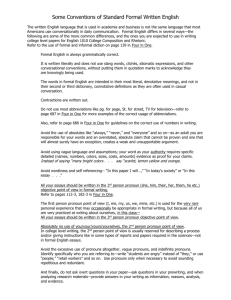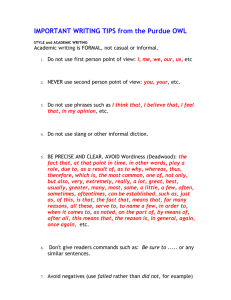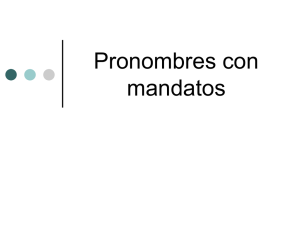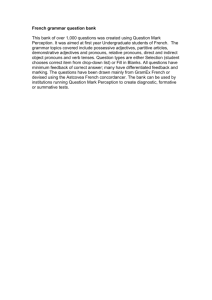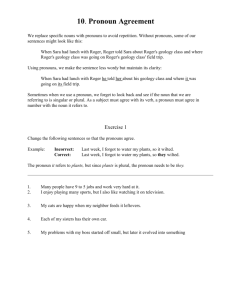RT 11 Pronoun Agreement
advertisement
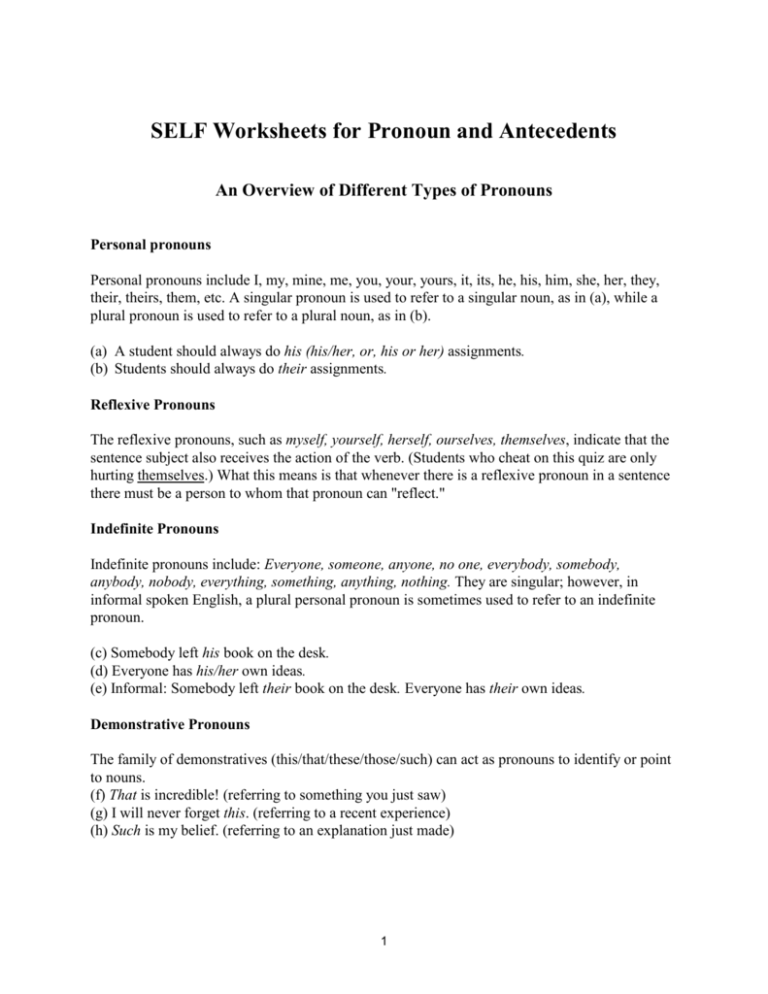
SELF Worksheets for Pronoun and Antecedents An Overview of Different Types of Pronouns Personal pronouns Personal pronouns include I, my, mine, me, you, your, yours, it, its, he, his, him, she, her, they, their, theirs, them, etc. A singular pronoun is used to refer to a singular noun, as in (a), while a plural pronoun is used to refer to a plural noun, as in (b). (a) A student should always do his (his/her, or, his or her) assignments. (b) Students should always do their assignments. Reflexive Pronouns The reflexive pronouns, such as myself, yourself, herself, ourselves, themselves, indicate that the sentence subject also receives the action of the verb. (Students who cheat on this quiz are only hurting themselves.) What this means is that whenever there is a reflexive pronoun in a sentence there must be a person to whom that pronoun can "reflect." Indefinite Pronouns Indefinite pronouns include: Everyone, someone, anyone, no one, everybody, somebody, anybody, nobody, everything, something, anything, nothing. They are singular; however, in informal spoken English, a plural personal pronoun is sometimes used to refer to an indefinite pronoun. (c) Somebody left his book on the desk. (d) Everyone has his/her own ideas. (e) Informal: Somebody left their book on the desk. Everyone has their own ideas. Demonstrative Pronouns The family of demonstratives (this/that/these/those/such) can act as pronouns to identify or point to nouns. (f) That is incredible! (referring to something you just saw) (g) I will never forget this. (referring to a recent experience) (h) Such is my belief. (referring to an explanation just made) 1 Collective Pronouns In formal usage, a collective noun followed by a pronoun takes a plural verb, especially if the pronoun and verb occur in the same sentence, as in (i) and (j). Examples of collective nouns: audience, class, committee, couple, crowd, faculty, family, group, staff, team. Note: Government and public are usually followed by plural verbs in British usage but by singular verbs in American usage. (i) My family are loving and supportive. They are always ready to help me. (j) The faculty have signed their contracts. In informal usage, a collective noun usually takes a singular verb, particularly if the collective noun is considered a single unit. (k) My family is large. It is composed of nine members. Relative Pronouns The relative pronouns (who/whoever/which/that) relate groups of words to nouns or other pronouns (The student who studies hardest usually does the best.). The word who connects or relates the subject, student, to the verb within the dependent clause (studies). 2 SELF Worksheets for Pronoun and Antecedents INTERMEDIATE LEVEL Exercise 1 – Decide whether the words in bold in the following passage are correct or incorrect. If a word is correct, put a C in the space provided. If it is incorrect, suggest the change. (8 marks) The reporter told Rebecca and I (1) _________ that she wanted to do a story about our next door neighbors, an elderly couple who are always ready to help anyone in need in the neighborhood.. Although everyone in the neighborhood have great admiration for his (2) _________ neighbors, none of us get (3) _________ the chance to show our appreciation to them (4) _________. Everyone in our neighborhood thinks our neighbors deserve to have a special article written about them (5) _________. Each of them has their own (6) ____________ story to tell. Both (7) _________ have been involved in community service work for years and are well respected but, somehow, the town has never given them the special award they deserve. If they receive this award this year, I hope that Rebecca and me (8) _________ will be able to attend the ceremony. Exercise 2 - Supply pronouns for the blanks in the following passage. In some of the blanks there is more than one possibility. (12 marks) Many wild animals are threatened by man. In the media, attention is most often concentrated on the problems of the whale, but many other animals are in danger, too. Here is some information about three of (9) _________. 1 The American bison. In the year 1700, more than 60 million bison wandered freely in North America. (10) _________ range was very wide and they were still multiplying despite being hunted by Indians. Today, the bison population of North America is around 10,000, a mere fraction of the former total. How has this terrible decimation come about? The white man and (11) _________ rifle must take the blame. During the building of the Union Pacific Railway, the bison were hunted more for pleasure than for (12) _________ meat. By the 1890s, only a few hundred bison were left. The recent increase in numbers has been made possible only by strict 3 government control over hunting. Now the bison is threatened more by infectious disease than by hunters. (13) _________ breeding areas are all protected. 2 The tiger. The tiger has suffered badly from (14) _________ reputation as the enemy of man. It has been hunted so extensively that there are now probably fewer than 1,000 tigers in the wild. Members of the tiger population have decreased in proportion to the expansion of human population in areas (15) _________ it used to roam freely. The human population of Asia has grown so dense that the future of the tiger looks black. Soon the only tiger may be in zoos. 3 The Komodo dragon. The Komodo dragon is the world's largest lizard. (16) _________ was not discovered until this century and was named only in 1912. It was formerly found on three Indonesian islands: Komodo, Rintja and Flores (17) _________ there were plenty of deer and wild pigs, the dragon’s normal diet but animals (18) _________ the islanders also hunted. With the increase of the human population, the dragon often got too little to eat. By the 1930s in spite of government protection, the population of this great hunting lizard had been reduced to a few hundred. It was, however, still found on the three main islands of (19) _________ range and there were still individuals of over 4 metres in length. By 1963, after an interval of only fifty years since its discovery, almost the entire population was based on Komodo. It is now unusual to see (20) _________ as long as 3 metres. The komodo dragon will certainly die out soon unless its hunting and breeding grounds are protected more effectively. (Adapted from Bolitho A. R. and Sandler P. L. (1980), Study English for Science, Longman Group Ltd, Essex: England.) Key to the intermediate level: Exercise 1 – (1) me, (2) their, (3) gets, (4) C, (5) C, (6) his or her own, (7) C, (8) I Exercise 2 – (9) them, (10) their, (11) his, (12) their, (13) its, (14) its, (15) where, (16) It, (17) where, (18) which or that, (19) its, (20) one 4
